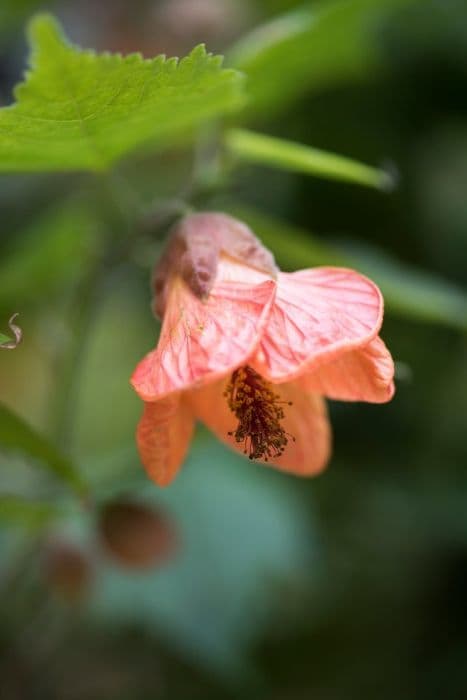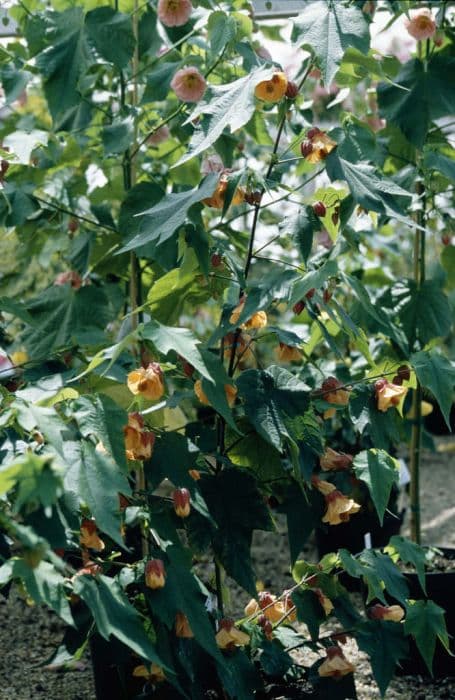Large-leaved Linden Tilia platyphyllos 'Rubra'

ABOUT
The Tilia platyphyllos 'Rubra', commonly known as the Large-leaved Linden or Large-leaved Lime, is a deciduous tree that is notable for its distinctive heart-shaped leaves. These leaves are large in size and have a somewhat asymmetrical base. During the growing season, they exhibit a rich green color. The tree produces creamy-yellow, fragrant flowers that are attractive to bees and bloom in clusters during the early summer. The 'Rubra' variety is also recognized for the reddish color of its young twigs and shoots, adding to its ornamental appeal. Its bark is grey-brown and develops a distinctive, sturdy appearance as the tree matures. The fruit of the Large-leaved Linden is small, rounded, and woody, often persisting into the winter months until they are dispersed. Overall, the plant has a rounded to broadly spreading crown that provides dappled shade, making it well-suited for parks and large gardens.
About this plant
 Names
NamesFamily
Malvaceae.
Synonyms
Large-Leaved Lime, Large-Leaved Linden, Broad-Leaved Lime.
Common names
Tilia platyphyllos 'Rubra'.
 Toxicity
ToxicityTo humans
The Large-leaved Linden (Tilia platyphyllos) 'Rubra', generally, is not known to be toxic to humans. It is a species of Tilia commonly found in Europe. In fact, various parts of the linden tree, such as the flowers, have historically been used to make teas and medicinal remedies for certain ailments such as colds or anxiety. There are no commonly reported toxic effects from consuming or handling the linden tree for humans.
To pets
The Large-leaved Linden (Tilia platyphyllos) 'Rubra' is not typically considered toxic to pets either. It is not listed among the toxic plants commonly recognized by major pet poison control organizations. Therefore, ingestion of this tree by pets is not expected to result in significant or serious toxicity. However, as with any non-dietary substance, consumption of large amounts of plant material may lead to gastrointestinal upset, such as vomiting or diarrhea, simply due to the ingestion of non-food items.
 Characteristics
CharacteristicsLife cycle
Perennials
Foliage type
Deciduous
Color of leaves
Green
Flower color
Yellow
Height
65 feet (19.8 meters)
Spread
40 feet (12.2 meters)
Plant type
Tree
Hardiness zones
4
Native area
Europe
Benefits
 General Benefits
General Benefits- Shade Providing: The large canopy of Tilia platyphyllos 'Rubra' offers ample shade, creating cooler areas underneath which are preferred during hot summer months.
- Aesthetic Appeal: With its striking red twigs and lush foliage, the tree adds visual interest and beauty to any landscape.
- Habitat for Wildlife: The tree provides shelter and food for various species of birds and insects, supporting local biodiversity.
- Seasonal Interest: It has seasonal changes that include spring blossoms and vibrant fall foliage, providing year-round visual interest.
- Urban Tolerance: This variety is quite tolerant of urban pollution, making it suitable for city environments and along streets.
- Sound Barrier: The tree's dense foliage can act as a sound buffer, reducing noise pollution in busy areas.
 Medical Properties
Medical Properties- Soothing agent: The flowers are traditionally used to calm nerves and reduce anxiety.
- Anti-inflammatory: Tilia flowers have properties that may reduce inflammation in the body.
- Sedative: The plant is sometimes utilized for its sedative effects in treating insomnia and promoting better sleep.
- Diaphoretic: Tilia is known to induce sweating which can be beneficial in breaking fevers.
- Expectorant: It has been used to relieve coughs and to help clear mucus from the respiratory tract.
- Antispasmodic: May help in relieving muscle spasms or cramps.
 Air-purifying Qualities
Air-purifying QualitiesThis plant is not specifically known for air purifying qualities.
 Other Uses
Other Uses- Woodworking: The wood of the Large-leaved Lime is soft and easy to work with, making it suitable for intricate carving and turning, especially in creating musical instruments.
- Food Flavoring: The flowers of the Large-leaved Lime can be used to infuse a sweet, floral flavor into honey and syrups, enhancing desserts and beverages.
- Natural Dyes: The bark and leaves can be processed to create natural dyes for coloring fabrics or paper.
- Beekeeping: The flowers are extremely attractive to bees, and lime blossom honey is a prized variety with a distinct flavor.
- Landscape Design: Due to its attractive foliage and form, it is used as an ornamental tree in parks and large gardens for shade and aesthetic purposes.
- Animal Bedding: The wood shavings from Large-leaved Lime are soft and can be used as bedding for small rodents and other pets.
- Culinary Garnish: The flowers can be crystallized with sugar and used as an elegant edible garnish on desserts or beverages.
- Educational Material: The tree's life cycle and response to environmental conditions provide a resource for educational studies in botany and ecology.
- Art Supplies: The charcoal made from the wood is valuable for artists as a drawing material with a unique consistency and color.
- Canvas Substitute: The inner bast fiber of the lime tree has been historically used as a substitute for canvas in painting or as a support material in frescoes.
Interesting Facts
 Feng Shui
Feng ShuiThe Largeleaf Linden is not used in Feng Shui practice.
 Zodiac Sign Compitability
Zodiac Sign CompitabilityThe Largeleaf Linden is not used in astrology practice.
 Plant Symbolism
Plant Symbolism- Love: The largeleaf linden, or Tilia platyphyllos 'Rubra', often symbolizes love and affection due to its heart-shaped leaves and its reputation as a tree under which lovers would traditionally meet.
- Peace and Tranquility: This plant is known to have a calming effect, making it symbolic of peace and tranquility, often found in places meant for rest and contemplation, like parks and avenues.
- Community and Social Gathering: Largeleaf lindens are commonly planted in social spaces such as village greens or town squares, symbolizing gathering, community unity and the importance of social bonds.
- Fertility and Renewal: With its prolific growth and abundant foliage, the largeleaf linden represents fertility, regeneration, and the continuation of life.
- Justice: Historically, the linden tree has been associated with courts and legal proceedings, symbolizing justice, fairness, and the objective nature of truth.
 Water
WaterLarge-leaved Lime trees, also known as Tilia platyphyllos 'Rubra,' prefer consistent moisture and should be watered deeply to saturate the root zone whenever the top few inches of soil feel dry. This typically translates to about 1-2 gallons for young trees each week during the growing season, depending on weather conditions and soil type. In periods of drought or extreme heat, the frequency may increase to two to three times per week. Over the winter months, water less frequently, but do not allow the soil to become completely dry.
 Light
LightThe Large-leaved Lime (Tilia platyphyllos 'Rubra') thrives best in full sun to partial shade. It should be planted in a location where it can receive at least four to six hours of direct sunlight daily, but it can also tolerate some light shade. Avoid deep shade since it can lead to poor growth and reduced foliage quality.
 Temperature
TemperatureLarge-leaved Lime (Tilia platyphyllos 'Rubra') is cold hardy and can withstand low winter temperatures, often tolerating dips as low as -20°F once established. The ideal growing temperatures for the tree are within the 60°F to 75°F range during its active growth season. However, it's adaptive and can survive summer highs up to around 90°F.
 Pruning
PruningPrune the Large-leaved Lime (Tilia platyphyllos 'Rubra') to remove dead or diseased wood, to shape the tree, and to improve air circulation which helps prevent disease. The best time to prune is in late winter to early spring before new growth starts. Pruning every few years is sufficient for mature trees, but young trees might need formative pruning more frequently.
 Cleaning
CleaningAs needed
 Soil
SoilLarge-leaved Lime 'Rubra', commonly known as Large-leaved Linden 'Rubra', prefers fertile, well-draining loamy soil with a pH between 6.0 and 7.5. The best soil mix can be achieved by combining garden soil, compost, and a smaller portion of sand or perlite to enhance drainage.
 Repotting
RepottingThe Large-leaved Linden 'Rubra' does not require frequent repotting as it is typically grown as an outdoor tree. It may only need repotting if grown in a container, which should be done every 3 to 5 years to refresh the soil and accommodate increased root growth.
 Humidity & Misting
Humidity & MistingThe Large-leaved Linden 'Rubra' is adaptable to a wide range of outdoor humidity conditions and does not require specific humidity levels for healthy growth when planted in the ground.
 Suitable locations
Suitable locationsIndoor
Not ideal for indoor growth due to its large size.
Outdoor
Plant in well-draining soil; full sun to partial shade.
Hardiness zone
3-7 USDA
 Life cycle
Life cycleTilia platyphyllos 'Rubra', commonly known as Large-leaved Lime or Largeleaf Linden, begins its life cycle when a seed germinates in spring, requiring well-drained soil and preferably full sun to partial shade. The seedling stage follows, where the tree experiences rapid vegetative growth and starts to develop its characteristic heart-shaped leaves. As it enters the juvenile stage, the tree continues to grow both in height and girth, establishing a sturdy trunk and a broad canopy. Reproductive maturity is reached after several years, at which point the tree produces fragrant flowers that attract pollinators and subsequently form small, nut-like fruit. Throughout its adult life, the Largeleaf Linden may undergo periods of annual growth and dormancy, responding to seasonal changes. Finally, the tree reaches senescence, where growth slows, and it may become more susceptible to environmental stresses, pests, and diseases, eventually leading to its death after potentially several centuries.
 Propogation
PropogationPropogation time
Spring-Early Summer
The most common method of propagating Tilia platyphyllos 'Rubra', also known as Red Twig Lime or Large-leaved Linden, is through semi-hardwood cuttings. This process typically takes place in late summer. Cuttings should be taken from new growth that is just beginning to harden but is still flexible. It is advisable to select a healthy, disease-free shoot and make a cutting about 6 to 10 inches (15 to 25 centimeters) in length, ensuring there are several nodes present. The bottom cut should be made just below a node, and the leaves on the lower half should be removed to expose the nodes. The cut end is often dipped in rooting hormone before being placed in a well-draining potting mix. The cuttings should be kept moist and in a warm environment with indirect light to encourage root development.









